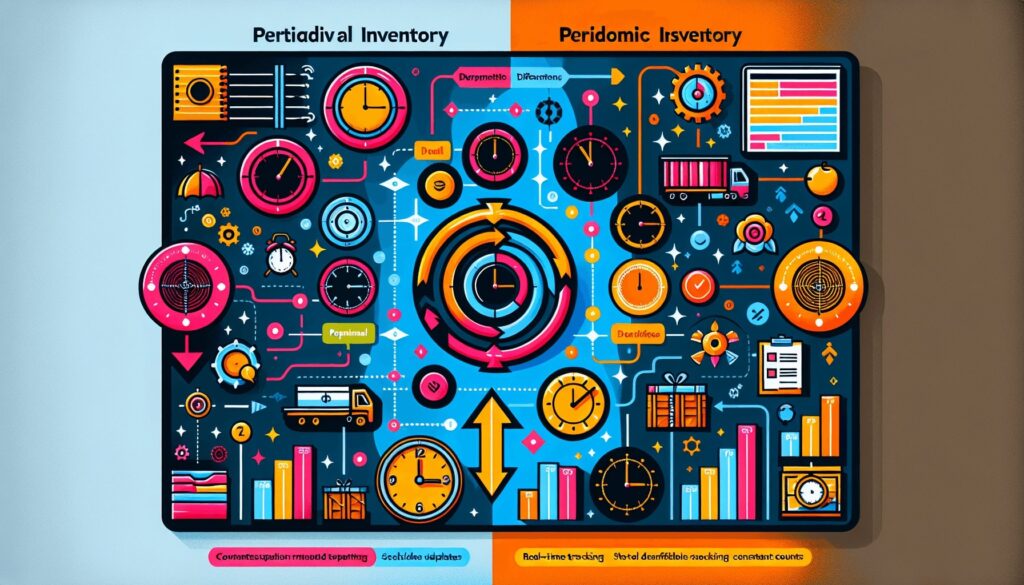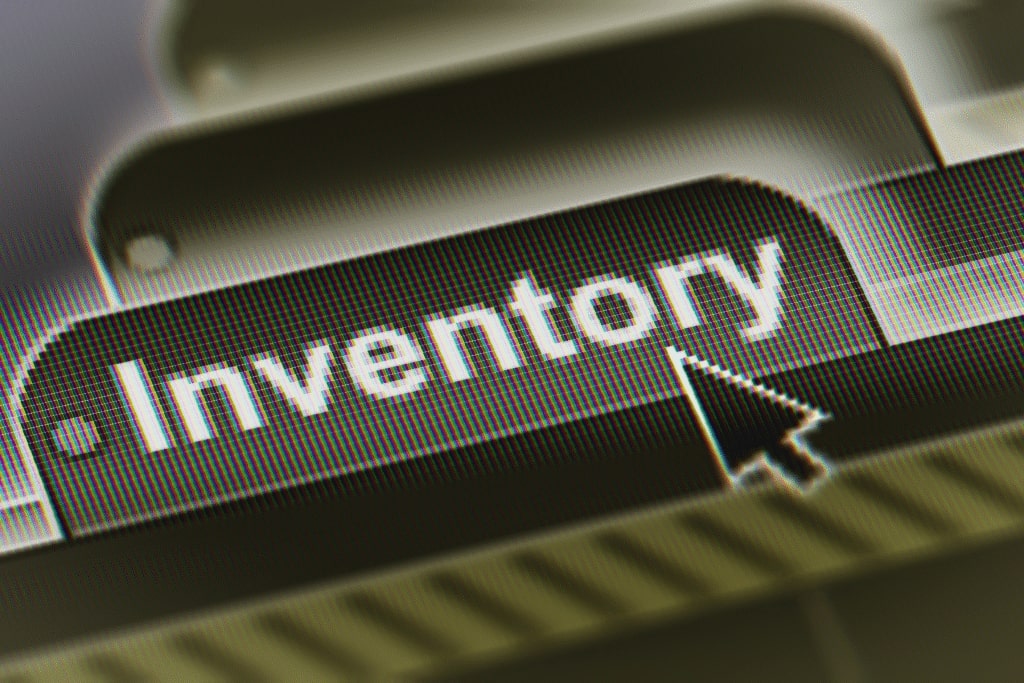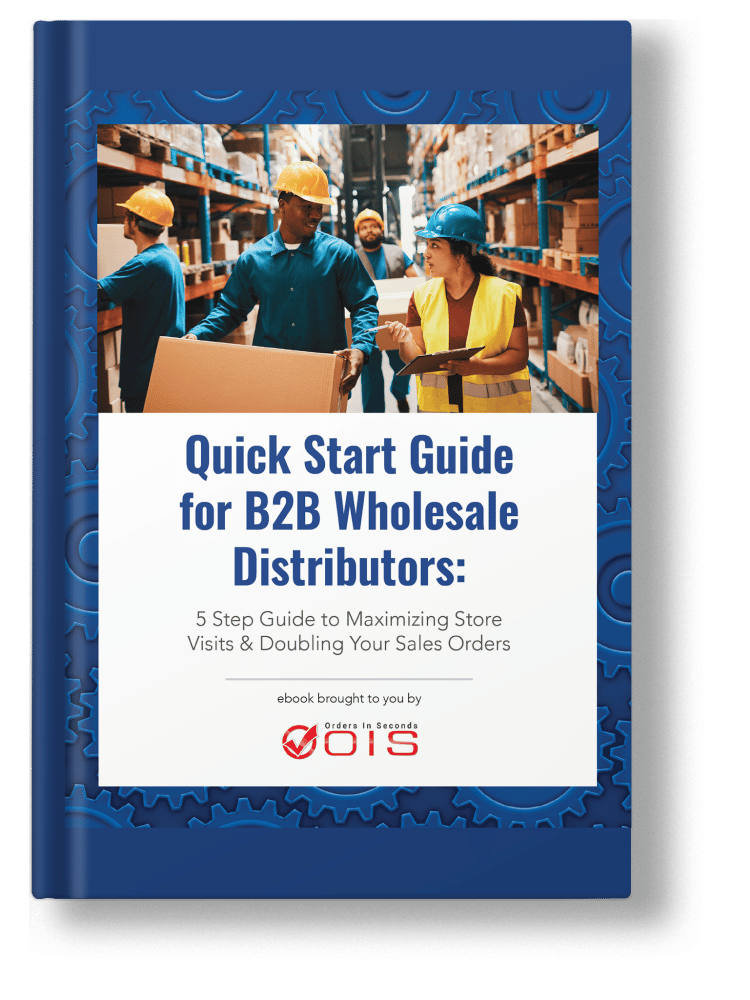Deciding between perpetual and periodic inventory systems is key for managing inventory. This article outlines the main differences, costs, and benefits to help you choose the best approach. Learn how understanding perpetual vs periodic inventory can optimize your business operations.
Key Takeaways
- Perpetual inventory systems provide real-time updates and detailed tracking, making them suitable for larger businesses, while periodic systems are simpler and more cost-effective for small businesses.
- Choosing the right inventory system involves assessing factors such as business size, industry complexity, and technological capabilities to align with operational goals.
- Both systems have challenges: perpetual systems require significant investment and reliance on technology, whereas periodic systems lack real-time data and can lead to inventory inaccuracies.
Table of Contents
- What is Inventory Management?
- Understanding Perpetual and Periodic Inventory Systems
- How Perpetual Inventory Systems Work
- How Periodic Inventory Systems Work
- Key Differences Between Perpetual and Periodic Inventory Systems
- Inventory Valuation Methods
- Advantages of Perpetual Inventory Systems
- Advantages of Periodic Inventory Systems
- Challenges of Perpetual Inventory Systems
- Challenges of Periodic Inventory Systems
- Choosing the Right Inventory System for Your Business
- Implementing Perpetual Inventory Systems
- Implementing Periodic Inventory Systems
- Impact on Financial Reporting
- Technology in Inventory Management
- Real-World Examples
- Summary
- Frequently Asked Questions
- Support Your Inventory Strategy with the Right Tools
What is Inventory Management?
Inventory management is the process of overseeing the storage, movement, and sale of inventory. It involves tracking inventory levels, monitoring inventory movements, and making informed decisions about inventory management. Effective inventory management is crucial for businesses to ensure that they have the right products in the right quantities at the right time. It helps businesses to minimize stockouts, overstocking, and waste, and to maximize customer satisfaction and profitability.
Effective inventory management involves several key activities. These include maintaining accurate inventory records, forecasting demand, and implementing efficient inventory tracking systems. By doing so, businesses can ensure they have the right amount of stock to meet customer demand without overstocking, which ties up capital and increases storage costs.
Modern inventory management often leverages technology, such as inventory management software, to streamline processes and improve accuracy. These tools can automate many aspects of inventory management, from tracking inventory levels to generating purchase orders, making it easier for businesses to manage their stock efficiently.
Understanding Perpetual and Periodic Inventory Systems

The backbone of effective inventory management lies in choosing the right inventory system. The two main types are perpetual and periodic inventory systems. A perpetual inventory system continuously updates inventory records with every transaction, providing real-time data that helps prevent stockouts and overstocking. Large businesses with complex inventory needs benefit from this system, which offers detailed insights and reduces human error.
In contrast, periodic inventory systems update inventory counts only at specific times through scheduled physical counts. This method is simpler and more cost-effective, making it suitable for small businesses with fewer products. After a physical count, businesses compare the physical inventory to recorded levels, which can highlight discrepancies but lacks the immediacy of perpetual systems.
Inventory purchases are tracked and managed differently in perpetual and periodic inventory systems. In a perpetual system, each purchase is immediately recorded, ensuring up-to-date inventory levels. In a periodic system, purchases are recorded in a purchases account and reconciled during physical counts, which can affect cost management and record accuracy.
Various factors, such as business size, industry, and technological capabilities, influence the choice between these systems. A clear understanding of these differences helps in making an informed decision that aligns with operational and financial goals.
How Perpetual Inventory Systems Work
Perpetual inventory systems are designed to record stock levels automatically as transactions occur, ensuring immediate updates. Real-time track inventory enables continuous monitoring of stock levels, offering a clear and accurate inventory picture at any moment. When a product is scanned upon receipt, it is instantly integrated into the inventory management dashboard, becoming available for sale immediately.
Recent technological advancements have made perpetual inventory systems even more efficient. The use of IoT devices, barcodes, and RFID technology allows for seamless and accurate inventory tracking. Ecommerce businesses like Tonies use these systems for real-time inventory visibility, enhancing operational efficiency and demand forecasting.
Perpetual systems automatically generate purchase orders when stock levels hit predefined reorder points, streamlining replenishment. Automation helps maintain optimal inventory levels and reduces the risk of stockouts during peak seasons.
How Periodic Inventory Systems Work
Periodic inventory systems involve counting inventory at set intervals, such as monthly, quarterly, or annually, within an accounting period. Businesses start with a physical review of stock to establish a baseline for future counts. The initial physical inventory count serves as the starting point for valuation and future inventory calculations. In these systems, the purchases account is used to record and manage inventory purchases, ensuring accurate cost of goods sold and financial reporting under GAAP standards.
These systems offer a snapshot of inventory levels at counting times, which can vary significantly over time. This approach is often simpler and more cost-effective, making it ideal for small businesses with fewer products. The lower ongoing costs and ease of implementation make periodic inventory systems appealing to small businesses.
The primary limitation of periodic systems is the lack of real-time data, which can lead to inaccuracies and inefficiencies. Reliance on scheduled counts during busy periods can limit operational efficiency and timely decision-making, making inventory management particularly challenging. The simplicity of periodic systems can become a drawback as businesses grow and their inventory needs become more complex.

A primary difference between perpetual and periodic inventory systems lies in the cost and complexity involved. Perpetual inventory systems require significant technology investment and ongoing maintenance, making them more costly to implement and manage. Periodic systems are more economical and simpler, making them particularly suitable for small businesses with manageable inventory levels.
Perpetual inventory systems utilize computerized methods for real-time tracking, offering detailed and timely updates on inventory levels. This makes them ideal for larger retail businesses with high transaction volumes and complex inventory requirements. On the other hand, the perpetual inventory method and periodic systems rely on physical counts at set intervals, providing a less frequent but sufficient snapshot for smaller operations.
Another critical difference is accuracy. A perpetual system is generally more precise, reducing errors and discrepancies compared to periodic systems, which can suffer from human counting mistakes. Businesses looking to scale or those with complex supply chains benefit from perpetual systems’ detailed tracking capabilities and timely updates, essential for effective inventory management.
Inventory Valuation Methods
Inventory valuation methods are used to determine the value of inventory for financial reporting purposes. There are several inventory valuation methods, including:
- First-In, First-Out (FIFO): This method assumes that the oldest items in inventory are sold first. It is commonly used in industries where inventory is perishable or has a limited shelf life, such as food and pharmaceuticals.
- Last-In, First-Out (LIFO): This method assumes that the most recent items in inventory are sold first. It is often used in industries where inventory is not perishable and has a long shelf life, such as manufacturing and raw materials.
- Weighted Average Cost (WAC): This method calculates the average cost of all items in inventory. It is useful for businesses with large volumes of similar items, as it simplifies the valuation process.
- Specific Identification: This method values each item in inventory separately. It is typically used for high-value or unique items, such as luxury goods or custom products.
The choice of inventory valuation method depends on the business’s specific needs and circumstances. For example, FIFO is often preferred in industries where inventory turnover is high, as it provides a more accurate reflection of current market conditions. LIFO, on the other hand, can be beneficial for businesses looking to reduce tax liabilities in times of rising prices, as it matches higher costs with current revenues.
Choosing the right inventory valuation method is crucial for accurate financial reporting and effective inventory management. It ensures that inventory costs are properly matched with revenues, providing a clear picture of a business’s financial health.
Advantages of Perpetual Inventory Systems

Perpetual inventory systems offer the advantage of real-time inventory updates, enabling businesses to monitor purchases and sales instantly. Immediate insight into inventory levels helps prevent stockouts and overstocking, enhancing overall operational efficiency. These systems also support more effective management of inventory across multiple locations, ensuring balanced and accurate stock levels throughout the business.
Another significant benefit is the reduction of downtime associated with physical inventory counts. Retailers using perpetual inventory tracking can reduce manual inventory management tasks, leading to lower labor costs and improved efficiency. Perpetual systems also help reduce stock discrepancies and improve theft detection, offering a more secure and reliable inventory management solution.
Automating purchase orders is another key advantage. These systems can automatically adjust reorder points based on historical sales data, ensuring optimized inventory levels and avoiding stockouts during peak seasons. Enhanced forecasting capabilities allow better management of stock levels based on customer buying patterns, further improving operational efficiency.
Advantages of Periodic Inventory Systems

Small businesses often implement periodic inventory systems with basic tools, making them straightforward to use. Their simplicity allows businesses to manage inventory levels without requiring a major investment in sophisticated technology. For small operations, the periodic inventory method simplifies the process of tracking inventory, reducing the complexity and cost of inventory management.
Periodic systems offer the significant benefit of lower start-up and operational costs. Less time-consuming to set up than perpetual systems, the periodic system is attractive for new or smaller businesses looking to manage inventory without high costs. The minimal materials and training required make periodic systems cost-effective and easy to implement.
Periodic systems also reduce operational costs by eliminating the need for constant monitoring and sophisticated technology. For small businesses with limited SKUs and less complex inventory needs, periodic inventory systems are a practical and cost-efficient solution.

Avoid the Top 5 Mistakes Wholesale Distributors Make
Are you making one of the top 5 mistakes that plague wholesale distributors? Download our free eBook to find out. We’ve also included tips and guidance to help you save time and avoid costly mistakes.
Challenges of Perpetual Inventory Systems
Although advantageous, perpetual inventory systems come with several challenges. A primary drawback is the high initial cost associated with implementing these systems. The requirement for advanced equipment, software, and ongoing maintenance makes perpetual inventory systems a significant investment. Ongoing costs for software updates and system maintenance add to the overall management complexity.
High reliance on technology makes perpetual inventory systems vulnerable. Scanning errors, software malfunctions, and cybersecurity threats can impact inventory record accuracy. System failures can disrupt operations, underscoring the need for robust technological support and backup plans.
Challenges of Periodic Inventory Systems
Before:
Periodic inventory systems also present several challenges. A major drawback is the lack of real-time data, leading to unknown stock levels and complicating inventory management. The absence of continuous updates can make it difficult for businesses to maintain accurate inventory records, leading to potential errors and inefficiencies.
After:
Periodic inventory systems also present several challenges:
Lack of real-time data, leading to unknown stock levels
Complicating inventory management
Difficulty in maintaining accurate inventory records
Potential errors and inefficiencies
Another significant challenge is the difficulty in effectively tracking theft and loss. Scheduled physical counts in periodic systems can miss discrepancies occurring between counts. Infrequent assessments can lead to significant errors and missed revenue opportunities due to insufficient inventory movement tracking.
Choosing the Right Inventory System for Your Business
Selecting the right inventory system involves considering factors like specific needs, size, budget, and operational efficiency. Larger businesses or those with complex products often benefit more from perpetual inventory systems, whereas smaller businesses can effectively utilize periodic systems. Implementing a cycle count schedule aids effective inventory management by allowing regular partial inventory checks, ensuring accurate and up-to-date records.
Transitioning to a perpetual inventory system with less frequently moved stock can minimize disruption. Gradual integration of new technology and processes ensures a smooth transition and maintains operational efficiency.
Implementing Perpetual Inventory Systems
Transitioning to a perpetual inventory system requires overhauling existing processes and integrating advanced inventory solutions. Technologies like Zoho Inventory or QuickBooks Commerce facilitate this transition, offering tools for real-time inventory tracking. Staff training ensures proficiency in using the new technology, smoothing the transition process.
Shifting to a perpetual inventory system may require a cultural change within the organization, adopting a more data-driven approach to inventory management. Understanding real-time data during the transition impacts purchasing, sales, and customer service strategies.
Reducing the frequency of physical counts, this transition allows businesses to focus more on strategic decision-making.
Implementing Periodic Inventory Systems
Implementing a periodic inventory system requires conducting physical counts at set intervals, such as monthly or quarterly. Regular physical counts keep inventory records accurate and reflect true stock levels, providing a reliable snapshot at specific times. This system benefits smaller businesses by simplifying tracking and reducing costs, avoiding the need for complex software.
Periodic inventory methods enable businesses to manage inventory with minimal technology investment, ideal for small operations. Focusing on regular physical counts and maintaining accurate records allows businesses to manage inventory levels effectively without continuous monitoring and advanced systems.
Impact on Financial Reporting

The chosen inventory system significantly influences financial statements, determining how inventory records are maintained and viewed, impacting current asset values and gross profit margins. Consistent application of inventory valuation methods like FIFO or LIFO is critical for accurate financial assessment, especially during price fluctuations.
Accurate computation of ‘cost of goods sold’ (COGS) is crucial for maintaining reliable financial statements and influencing gross profit. Accurate inventory records directly affect the balance sheet and income statement, ensuring a dependable reported financial position. Automated systems for recording inventory values simplify financial statement preparation and enhance accuracy with real-time inventory balance updates.
Technology in Inventory Management
Modern inventory management heavily relies on technology. Barcode or RFID tracking technology is essential for maintaining inventory visibility and automating stock updates. RFID technology, in particular, enables real-time inventory tracking without manual intervention, offering a seamless and accurate inventory management solution.
Cloud-based inventory management software systems offer scalability and accessibility, efficiently collecting and interpreting data from various sources. This technology helps businesses maintain up-to-date inventory records, ensuring accurate stock levels and enhancing overall operational efficiency.
Real-World Examples
Small restaurants often benefit from periodic inventory systems. These systems are simple and cost-effective. These businesses typically have fewer SKUs and less complex inventory needs, making periodic systems an ideal choice for managing their stock levels effectively without significant investment in technology.
Summary
In conclusion, both perpetual and periodic inventory systems offer unique advantages and challenges. Perpetual systems provide real-time data and improved accuracy, making them suitable for larger businesses with complex inventory needs. Periodic systems, on the other hand, offer simplicity and cost-effectiveness, ideal for small businesses. Understanding the key differences and assessing your business needs will help you choose the right inventory system, ensuring efficient inventory management and accurate financial reporting.
Frequently Asked Questions
A perpetual inventory system updates inventory records in real-time with each transaction, ensuring accurate tracking and management of stock levels. This approach helps businesses avoid stockouts and overstocking effectively.
A periodic inventory system operates by conducting inventory counts at predetermined intervals, allowing businesses to assess their stock levels at specific points in time. This method provides a clear overview of inventory quantities but does not update stock records in real-time.
Perpetual inventory systems provide real-time updates and improved accuracy, allowing for better inventory management and reduced labor costs. Additionally, they facilitate automated purchase orders and enhance forecasting capabilities.
Periodic inventory systems present challenges such as lack of real-time stock level awareness, complicating inventory management and hindering effective tracking of theft and loss. These issues can significantly impact operational efficiency and accuracy.
Inventory systems significantly impact financial reporting by ensuring accurate inventory records, which influence current asset valuations and gross profit margins. Consequently, precise inventory management is essential for reliable financial statements.
Support Your Inventory Strategy with the Right Tools
Whether you’re using perpetual or periodic inventory systems, OIS Inventory offers real-time tracking, convenient barcode scanning, and error-free order picking, tailored for wholesalers, distributors, and manufacturers. Transition seamlessly with OIS Inventory and ensure accurate stock levels, efficient operations, and simplified order fulfillment—all from one user-friendly app.
Want to learn more? Schedule a FREE demo below!






